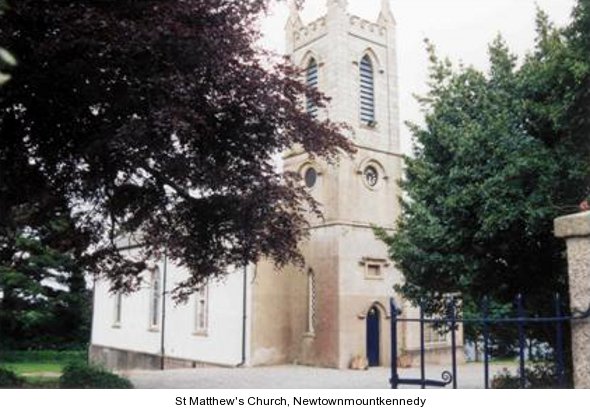Journal Volume 4 2004
A Priest, an Altar and a Window
By Canon Robert Jennings
Introduction
The Church of Ireland Church of St Matthew's Newtownmountkennedy has memorials to a number of famous people. It was built in 1836 as a Chapel of Ease for the Parish Church of Newcastle, which could no longer accommodate its growing population. It also became the centre of worship for the “gentry” of surrounding parishes. Parish records bear witness to this, as parishioners included not only those from the Parish, but also from G1endalough, Ballinastoe, Roundwood, Tinnapark, Dromin, Kilquade, Streamstown, Killincarrig, Delgany and Kilcoole. The morning congregation often numbered 270 and a 100 at the evening service. Rented stabling for horses as well as a bicycle shed were provided where Fishers shop now stands. The church still has the old box pews for which families paid a pew rent. Each pew has a lockable door, which gave privacy to the family and inside another small lockable cupboard for hymn books and prayer books, and hooks for gentleman's hats and ladies' handbags. At the back of the Church and in the extended gallery were open pews, which anyone could use without payment. Even as late as 1900, 25 families paid pew rents of between 15 shillings to £3 5s 0d per year. Pew rents were later abolished.

The most notable Rector of St Matthew's was Reverend Henry Irwin who ministered there for 32 years 1863 - 1895. For 80 years one or more of the Irwin family, father, the Revd. Henry Irwin, son Arthur, a lay reader, and daughter Amy travelled the two miles or so almost daily by pony and trap from their home, Prospect House (for there was no Rectory) to their beloved Church. They took the services, taught in the school and in Sunday School, cared for the Church, played the organ, visited the parishioners and the sick and were known and loved by all. As was said of Sir Christopher Wren, the architect of Westminster Abbey, if you wish to see the Irwins’ memorial, look around St Matthew's Church. The Irwins had six children, three of whom became missionary priests: Henry to Canada; Philip to Florida, where he was once tarred and feathered for befriending the blacks and later became archdeacon of Philadelphia; and Edward went to Kimberley South Africa. Arthur, a lay reader to his father, Amy and Lucy stayed at home in Ireland.
A Priest
Henry Irwin, or Father Pat as he was affectionately known all his life, was born on 2nd August 1859 at Prospect House, Newtownmountkennedy. As mentioned above, he was the eldest son of Henry Irwin. His grandfather was chaplain to the primate, Lord John Beresford. At the age of 12 young Henry went to St Colomba's College at Rathfarnham. The Warden of St Colomba's said of him:
“From the very first Henry showed high and strong principle, ever ready with his work, ever near the front in the playing field, ever attentive and devout in Chapel”. It is reported by some of his peers of those days that on one occasion “a ball from Henry's cricket bat just missed striking the head of Mrs Parnell who was mother of Charles Stuart Parnell and also of Henry Tudor Parnell, a student with Henry at the time in St Colomba's”.
In 1878 he entered Keble College, Oxford where he kept up his reputation as an athlete, rowing in the Torpids and Eights, and playing football and rugby. When he graduated from Oxford he went to Ely Theological College and in 1883 was appointed Curate of Rugby. Just 120 years ago, he followed a long-felt call and crossed the Atlantic to British Colombia. His parish there was almost as big as the whole of Ireland, 300 miles north to south and 100 miles east to west. In the tradition of many another from Co. Wicklow, he was a good horseman and travelled the whole of his parish on horseback. There, as a missionary priest, he ministered to the miners, railroad builders and scattered settlers and pioneers of this rough country. They all knew him as "Father Pat", friend and messenger of God.
Many stories are told of his bravery in rescuing men in that wild country and of his love and compassion for all men. In 1887 the Revd. Henry Irwin was moved from the rolling foothills of the Kamloops area to the railway town of Donald between the Colombia River and the towering Rocky Mountains. The railroad workmen in the winter were in constant peril from avalanches of snow, rock and trees. On one occasion 6 of 16 men were buried in a snow-slide and their bodies recovered and carried back to Donald. Father Pat Irwin was in the rescue party.

